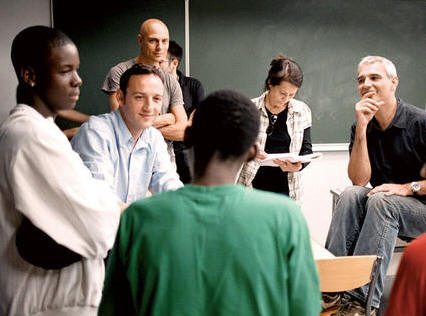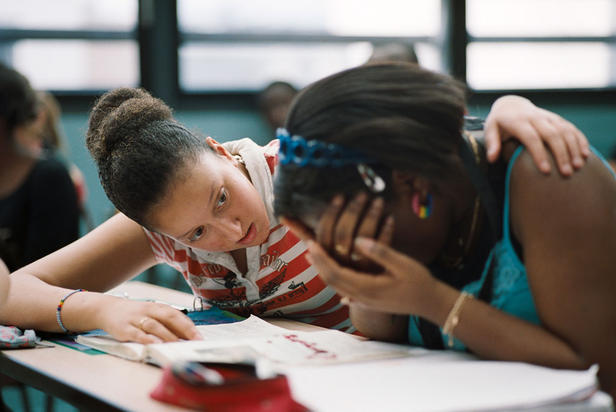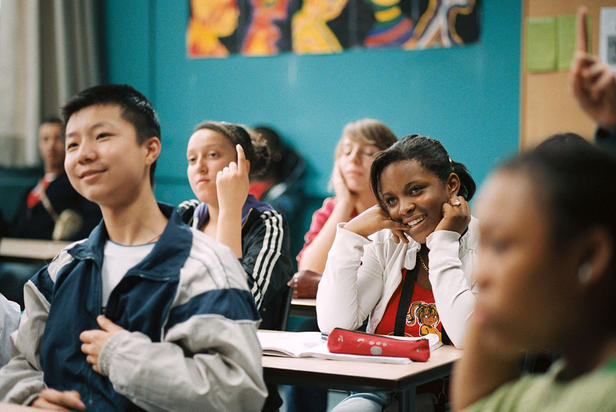Copyright ©2009 PopEntertainment.com. All rights reserved.
Posted:
February 18, 2009.
Using a
faux-documentary approach to ratchet up the verisimilitude, French
director Laurent Cantet makes a powerful examination of teaching and
student/teacher dynamics. The Class vividly depicts life inside a
Paris high school replete with the issues of race, class and individuality.
Based on teacher François Bégaudeau's autobiographical novel, the film uses
real students and teachers who were taught to act, including the author who
plays himself in the film. This neo-realist style essentially recreated the
classroom experience with unexpected results. The Class is the finest
example of Cantet's socially aware work which includes Heading South,
Timeout and Human Resources.
Being the first French film in 21 years to win the prestigious Palme d'Or
award at Cannes, The Class and Cantet went to the head of... well,
you know, and they accrued other accolades. It became the opening night film
of the prestigious New York Film Festival (Said NYFF lead programmer Richard
Pena, "Laurent Cantet has pioneered a new kind of social cinema") and is now
a nominee for the Foreign-language Feature Oscar.
As with your previous film Heading South, you address the clash of
cultures among the French. Why is this of such importance?
[It's] because we are now living in a multicultural society. A lot of people
are moving from one place to try to live a better life in another one, and
we have to take that into account. It's impossible not to look at this
issue, which is the same all [over the world]. So I thought it was
interesting, especially because the French are sometimes ashamed of the way
France is dealing with that question [of immigration.] The French say that,
"If you want to be part of the community, [you have to be] like this."
[That's] not a good way to look at things. This culture is not just of
Molière, Proust, and Sartre, it's also what we all live together, and what
we all live is this street culture. It's built by everybody in the country.
That's what people in France refuse [to acknowledge], and I wanted to show
how rich it could be to gather people from all over the world, from
different social levels too, and see how they can learn to live together.
 It
was an interesting decision to cast François, the author of the book and
screenplay, in the lead role. Why did you make this choice?
It
was an interesting decision to cast François, the author of the book and
screenplay, in the lead role. Why did you make this choice?
The question was at the beginning to know whether we were making an
adaptation or not. I don't think we made a real adaptation – it's more of an
extension of the book. François was very interested to see [whether] the
situation he lived once could happen in another class, so we were not trying
to have the same reactions [as were] in the book, but to see how these girls
and boys would take this situation, and [what they would do with] it. It was
interesting for François too to re-fashion the original material.
Did he learn something new as a result of that?
It was quite strange [that] what happened in front of the camera was from
what we wrote. Maybe because François and I were, by chance, aware of what
the children would think, and [because] we spent three hours every week with
the children in that workshop we had in school, we knew them quite well, and
were able to imagine what their reactions would be.
Can you describe the casting process? And what criteria did you use to
cast these non-professional young actors?
I didn't make any selection. In fact, we chose the neighborhood, which is
one of the most mixed parts of Paris – the 20th Arrondissement. I
then found a school there that was interested by the experience we were
proposing; we offered a workshop to all volunteers between thirteen and
fifteen [years old]. At the beginning, we had 50 students who came. [Then]
25 five of them [ended up leaving] because they weren't interested or wanted
to play soccer, or were uneasy in front of the camera. The 25 who stayed are
the ones who are in the film. After that, we had to find Souleymane [Franck
Keita] in the group, and decide who would be who, but that's all that I did.
Usually when you make a film with adolescents you meet thousands of them to
use one or two, but we just met 50 of them.
 How
did the kids surprise you?
How
did the kids surprise you?
The first time I met them I was absolutely sure we had found the good ones.
I had no doubt about them. For instance, Esmeralda, [we] saw her once and
knew, "Right, she can be the central character." They surprised me in the
way they were able to concentrate on what we were doing, and to think with
us, and to stay focused on the subject of the day. Six-hour days they were
able to sit in the class, and improvising the first take, but then
re-playing, reacting to what they proposed in improvisation for the second,
third, even sometimes, ten takes – [that took real concentration]. Like all
of us, they had some moments of lassitude, but six hours is quite long, you
know. And the teachers of the film were also their own real teachers in the
school; they were so jealous to see that we could focus their attention on
anything for six hours.
What else surprised the teachers?
They're used to having 25 children in front of them and knowing [that] one
will be focused for five minutes, for another, it will be for two, another
for seven, but never all together. I think we really gave [them a] sense to
what they were doing here. We really involved them in the process of making
the film, and they were really taken by that.
The film is mostly shot indoors, and doesn't become theatrical at any
point. It didn't seem to descend in theatricality where you shoot in certain
angles such as shot/countershot, etc. but had lots of long takes...
It was important for me to have long takes because I wanted to respect he
energy of the exchange. Sometimes you can have moments where nothing is
happening, and two seconds later it could start again and an incredible
thing could happen. It was one of the reasons why I chose to shoot in HD
video. That's also why I decided to have three cameras instead of one – to
have all the angles in the same shot. It was also why I decided to have
three cameras on the same side of the class – not to give more importance to
one over the other one; to not be in the point of view of anyone, but to
[have the audience] watch what is happening. What was very funny was, when
we started a take, you really couldn't stop before the end of it because I
was just fascinated by what was happening, and always surprised by what was
happening even if I really knew exactly what was going to happen. I think
that's why the film doesn't seem too claustrophobic, because things are
always arriving faster than you can think; you are always running behind it;
you are always surprised by one answer, one question, by the way they say
it. I couldn't cut the camera. I was just watching the things that were
happening.
This must have been a very transformative experience for the kids. How
did the film change them?
They were thirteen or fourteen years old. It's a moment where you transform
yourself, so it's difficult to know what the film brought to that process.
I'm sure they learned to involve themselves in something…. Give them a sort
of maturity. After that, maybe change their relationships to the teachers,
just because they worked together, and they had normal relationships with
them. When I did a Q & A in France, a young guy who was in the audience took
the microphone in front of, I think, 300 teachers behind him, which is
already not very easy – he was thirteen, fourteen years old – just saying
that he could recognize his own situation. But what interested him the most
was the image of the teachers. He told me, "I discovered that teachers can
speak together, and when they speak together they speak of us." This image
of a teacher for most children is just a function, [but] through the film,
through the experience they had working with the teachers and through what
the film was showing [as well], they realize that their teachers are human
beings. If the film can prove that to children, it already was quite a
success.
 It's
uncommon to hear students talk back in such a manner to the teacher. If I
did that in school I'd be asked to step outside!
It's
uncommon to hear students talk back in such a manner to the teacher. If I
did that in school I'd be asked to step outside!
What you have to understand is that we decided to film these special moments
when the teacher is asking for dialogue with the children. These moments
really accept a sort of equal-to-equal dialogue, which is risky, of course,
because you don't know what will happen at the start of these discussions –
but it is not always like that. The film is just two hours but that's
something that really happens, [with the students and teachers on equal
ground] and it surprises all the foreigners. I don't know if it was
something that happened after 1968, but we always have two representatives
of students in the teacher's conference. They have two roles: 1) which is to
tell the teachers if one of them has a problem, you can go and see your
representative and tell them, "this semester I had this and this and this
[happen]…" and 2) to tell the children what the teacher said. Of course,
it's usually more efficient than what you see in the film. In the film they
cross the line. The school is a small society, and in that society you can
be responsible for what you are doing.
In addition to putting a new multicultural face on French national
identity, was one of your aims to promote a new learning environment for
students? The film seemed to promote a Socratic method of teaching by
challenging students.
I'm not promoting anything. In fact, what interested me in the character the
book was proposing was exactly that – the way this teacher is always asking
questions to make the children understand what they are doing, as opposed to
lecturing [them]. I think lecturing can be effective sometimes, but after
two weeks, I think most of the children forget what they learned if [they
have] is no sense of what they learned.
Do you think this film could change French education or change French
society in a profound way?
At the release of the film a lot of people spoke about it, and a lot of
debates took place around it, so that's the best thing I could expect from
the film.
Email
us Let us
know what you
think.
Features
Return to the features page.